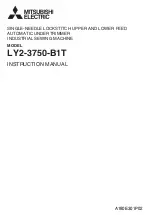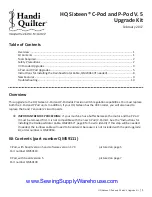
B
Manual Presser bar lifter
1 . Turn the presser bar lifter in the direction of
the arrow. This raises the presser foot.
C
Adjustment of the feed foot
and the presser foot
1 . Adjustment of alternating movement
( 1 ) The alternating movement on the feed foot
and the presser foot can be adjusted by using
the adjusting dial located on the top cover.
( 2 ) Face the desired number printed on the
dial to the matching mark located on the
top cover.
( 3 ) The number printed on the dial represents the
possible protrusion of the feed foot and presser
foot from the throat plate when the alternating
movements on these are evenly set.
( 4 ) If the alternating movements are evenly
set, they can be readjusted up to 2.0 to
5.0 mm.
2 . To change the balance of the alternating movements
between the feed foot and presser foot
( 1 ) For example, to increase the rise of the feed
foot, and decrease the rise of the presser foot.
①Remove the rubber plug located on the top
cover.
②Turn the pulley until the presser foot is
slightly raised from the throat plate.
③Loosen the set screw Ⓐ (on the right side)
located on the feed lifting rock shaft crank
(right).
④The built-in spring pulls down the presser
foot until it makes contact with the throat
plate. Then, tighten the set screw Ⓐ.
⑤This completes the adjustment, i.e., the
protrusion of the presser foot has been
decreased by a set distance. And, the
vertical motion of the feed foot has been
increased by that same distance.
( 2 ) As a contrary case (1), to decrease the rise
of the feed foot, and increase the rise of the
presser foot.
First, turn the pulley until the feed foot is
slightly raised from the throat plate. Next,
loosen the screw Ⓐ. Finally, tighten the
screw Ⓐ again.
This decreases the rise of the feed foot.
HOW TO USE
Presser bar lifter
Alternating movement
adjusting dial
Matching mark
Presser foot
Feed foot
2.0 to 5.0 mm
Rubber plug
Set Screw Ⓐ
Feed lifting rock
shaft crank (right)
— 8 —






































